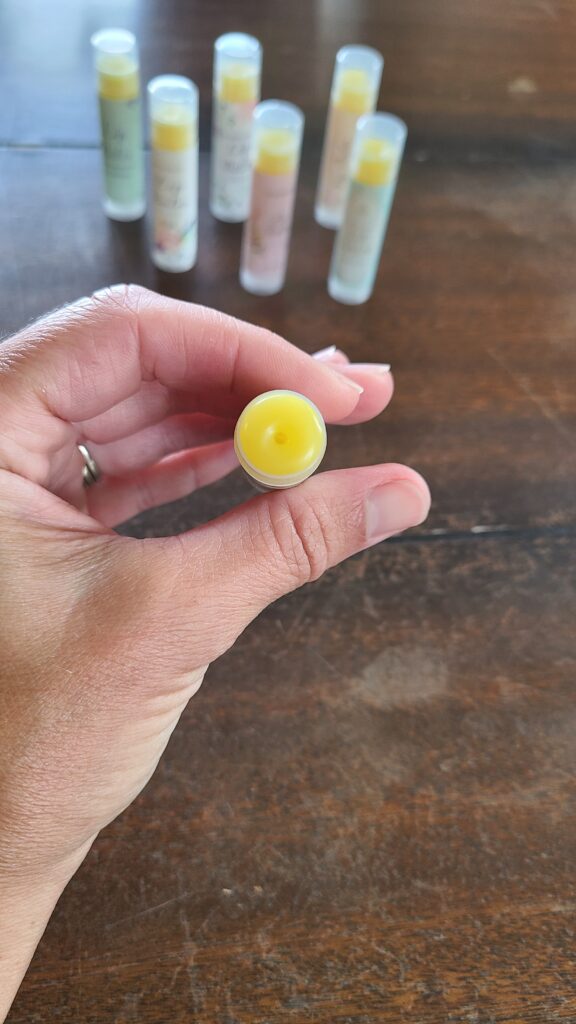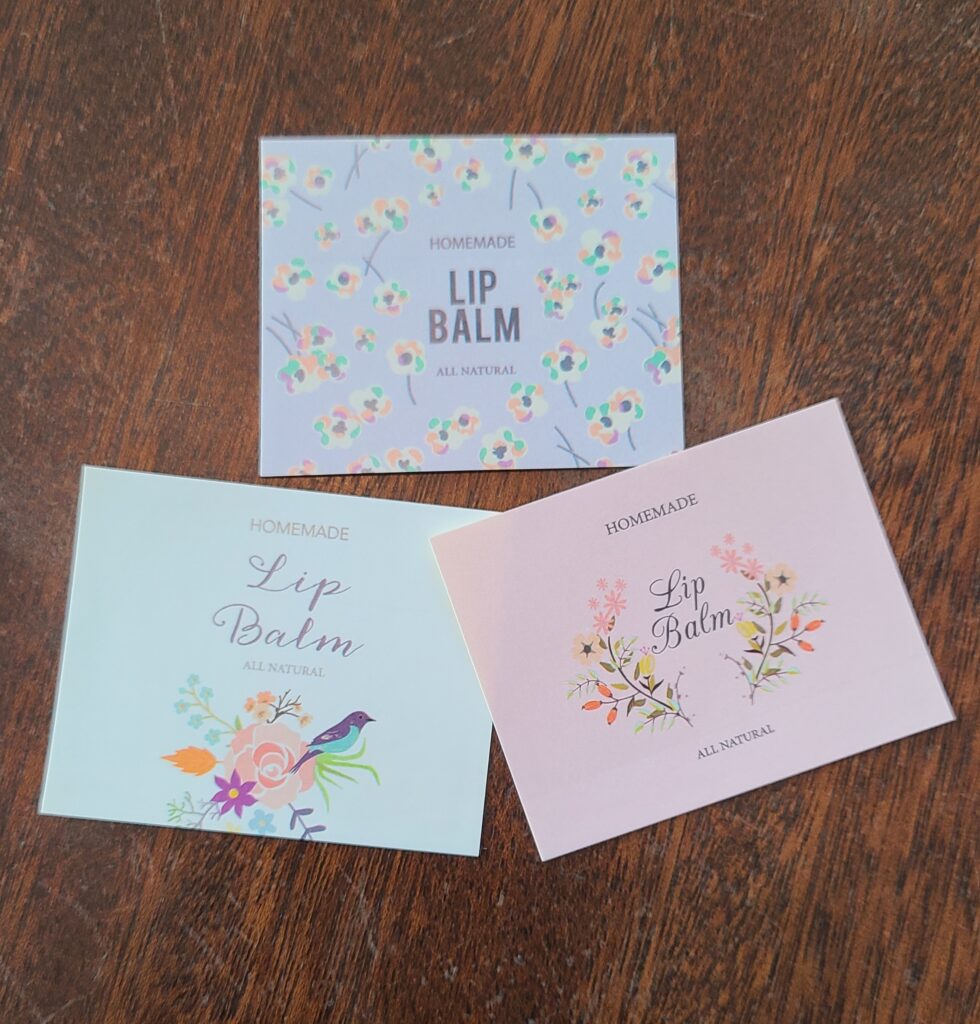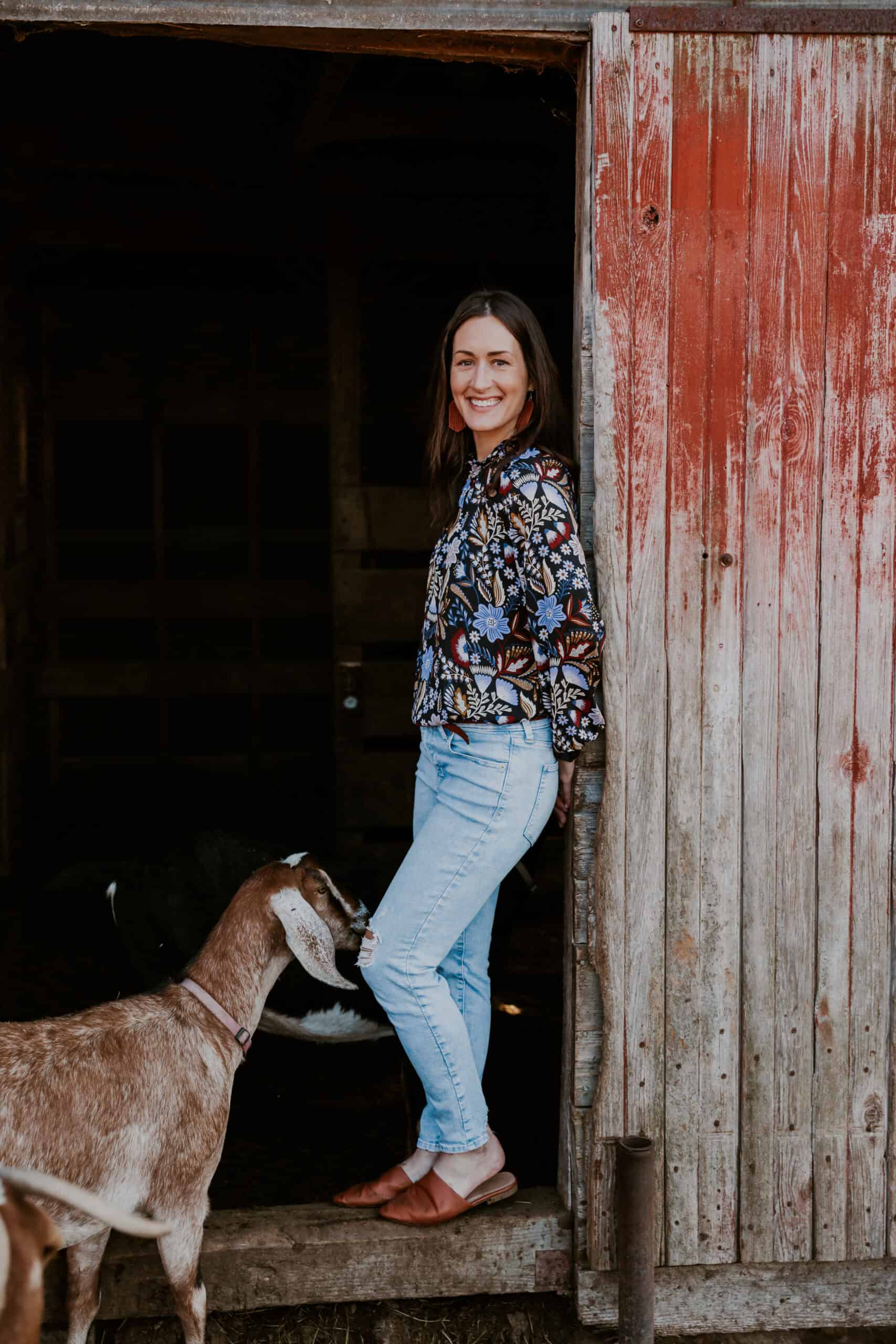This post contains affiliate links. As an Amazon Associate, I earn from qualifying purchases.
I am never without Chapstick. I have purse, car, coat, nightstand, and miscellaneous other lip balms strategically placed around me for easy access.
I live in Michigan and the summer sun and winter wind are always drying out my lips!
I have tried all the brands and flavors from the store and several do-it-yourself recipes. The recipe I’m sharing today is my favorite concoction that I have come up with because it goes on smooth and has substantivity- it keeps my lips nourished the longest.
No only that, but contains only natural ingredients and is fun and easy to make!

Materials for Homemade Lip Balm
- A heat-safe bowl for melting ingredients
- Something to stir the mixture with
- Kitchen scale
- Measuring spoons
- Double-boiler pot (saucepan with water on stove) or microwave
- Lip balm tubes or tins with lids
Optional:
- Baster
- Lip balm filling tray
- Cheese grater
- Labels
I like to use a microwave safe 1-quart glass measuring cup because it is heat safe and has a lip for pouring (then you don’t need the baster and filling tray). It is also easy to clean!
I use a stainless-steel spoon, rubber spatula, or wire whisk to stir my waxes and oils as they melt. I measure some of the ingredients by weight and some by volume. The larger quantity ingredients (wax, shea butter, coconut and olive oils) I weigh on a kitchen scale and the smaller quantity ingredients (vitamin E oil and essential oils) I measure by teaspoon or count out drops.
I have made this recipe for lip balm using a saucepan with water for the double-boiler method, but I have used the microwave to melt the ingredients too. I know both work, but to maintain the benefits of the oils you don’t want to overheat them- so the double-boiler method is probably the best method because you have more control over the heat.
You can order lip balm tubes or tins off Amazon. For tubes, I look for ones that are BPA free and made with food grade plastic.
Using a baster isn’t necessary, but it does make the job of filling the tubes easier and less messy. As the oils cool and solidify the baster may get clogged and running it under hot water may be necessary.
A lip balm filling tray simply holds onto tubes so that you don’t have to during the filling process. Instead of using one, you can rubber band a group of 10-15 tubes together to make them more stable.
A grater is necessary only if you are using a block of wax. I am a beekeeper and render my own beeswax and pour it into forms so I do have to break some off, weigh it, and then grate it down to use it in lip balm.

Beeswax has the highest melting point of all the ingredients used in this recipe, so grating (so it is in tiny pieces) helps it to melt more quickly. You will be waiting and stirring for a long time if your wax is in a chunk!
Labels aren’t necessary, but I found these super cute floral ones on Amazon that I love! They fit perfectly on the tubes and say “Homemade Lip Balm All Natural.” If you don’t want to be fancy, you can just write the flavor on the tube with Sharpie.

Ingredients for Homemade Lip Balm
- 1 oz. wax (beeswax or candelilla or a combination)
- 2 oz. raw shea butter
- 0.5 oz organic virgin coconut oil
- 0.5 oz organic extra virgin olive oil (EVOO)
- 0.5 tsp vitamin E oil
- 10-15 drops edible essential oil
The wax gives the lip balm some nice structure and the correct amount of stiffness. I am partial to beeswax, but candelilla is another option (and its vegan too).
The shea butter makes the Chapstick nice and creamy and moisturizing. I used to make lip balm with just oils and waxes and I found this is the magical ingredient that was missing.
Coconut oil is a staple in skincare products because it is moisturizing, as well as antibacterial and anti-inflammatory. Similarly, the EVOO helps protect and nourish the skin as well as allow for the lip balm to glide as it is applied.
Vitamin E oil aids in moisturization, while it also acts as a powerful antioxidant that combats ultraviolet radiation skin damage.
I have used food grade peppermint, lavender, and vanilla essential oils in my lip balms. Just be careful which essential oils you use, because not all are safe to use on the lips. Depending on which you use, they may add therapeutic benefits besides just making the lip balm smell and taste delicious!
Directions for Making Homemade Lip Balm
Makes 25- 0.15 oz. tubes or 20-5.5 ml tubes

- Using a kitchen scale, weigh out 1 oz. of wax (grating if necessary) and place it in the heat-safe mixing bowl.
- Tare the scale and add 2 oz. of shea butter to the wax pieces.
- Tare the scale and add 0.5 oz of coconut oil to the mixture.
- Tare the scale and add 0.5 oz of olive oil to the mixture.
- Apply heat to the mixture until it is a homogenous liquid. Option 1: Put the mixing bowl into the double-boiler pot and stir slowly while the ingredients melt. Option 2: Put the mixing bowl into the microwave for 20 seconds at a time, stirring at each interval.
- Remove the bowl from the heat and add 0.5 tsp of vitamin E oil and stir.
- Add 10-15 drops of essential oil. Stir again.
- Carefully pour the mixture into tubes or tins using the pointed rim on the mixing bowl or use a baster to fill the containers.
- If the mixture cools too much and hardens, re-heat the ingredients to their liquid state and begin pouring again until all of the mixture is in a lip balm container.
- Starting cleaning up while the lip balm cools and hardens. Add some water to the mixing bowl and heat it back up for easier clean up.
- Let the lip balm cool completely (about 30 minutes) and wipe off any mess from the outside of the containers.
- Affix labels and enjoy!

Do you have a favorite lip balm recipe? Share it with us below!

Mother, farmer, author, and teacher by trade… She loves tending to things and watching them grow!
